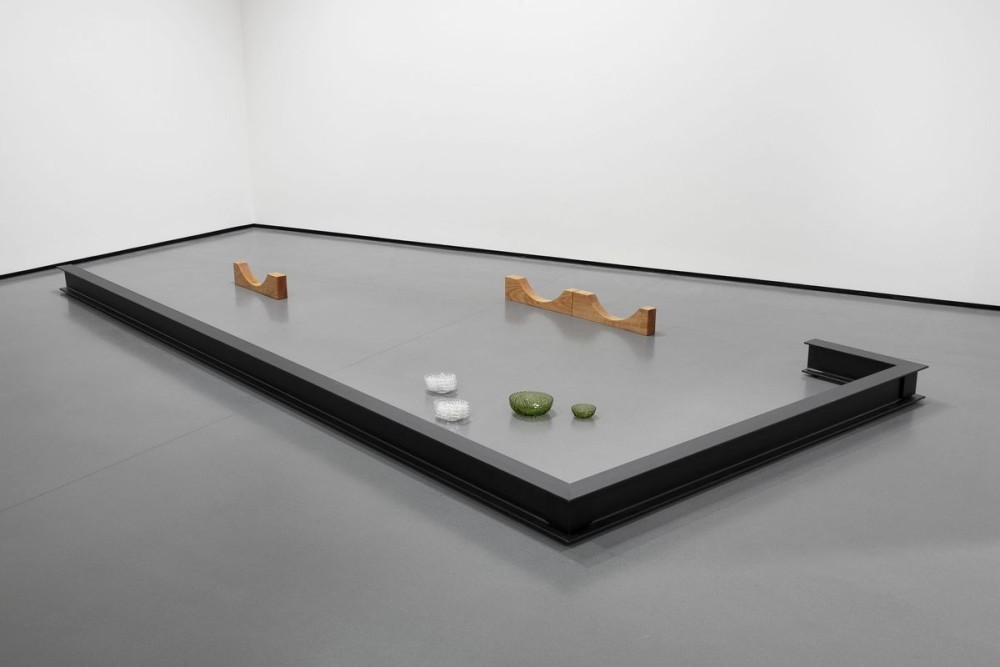
Leslie Hewitt: New Waves
Leslie Hewitt’s photographs turn our perceptual assumptions about viewing upside down—or perhaps more accurately, they quite literally ground perception with the force of gravity. In her self-described still life photographs, a series Hewitt has been making since 2004, chromogenic prints rest inside of custom-made frames, which are placed on the floor and leaned against a wall. Encountering these works requires a full body act of looking, a physical experience that slows down perception.
Gravity, and a slowing of perception, also come into play within the depicted space of Hewitt’s photographs. If concepts like floor, and lean, are central to the artworks as physical objects, they also figure prominently within the still life scenes Hewitt presents us with. In Untitled (Maddened by Love), 2019, for example, a neatly stacked pile of five books rests on the floor, pushed up against a wall. On top of this stack of books is placed a rectangular—just slightly wide of square—plank of elm wood, its flat surface facing us as it leans against the wall of the space within the photograph. The gravity and lean that govern Hewitt’s artwork-as-object are repeated by the gravity and lean of the wooden plank—a subtle play on the visual and literary device of mise-en-abyme (literal translation: “placed into the abyss”), of an image within an image. In Untitled (Maddened by Love) there is yet another image within an image, a photo placed carefully at the top of the wood plank and stacked books arrangement. One can just make out what appears to be three figures set against an expanse of sky and sea, an anonymous snapshot marking a moment in place and time.
What should we make of the unadorned surface of the not-quite-blank wood plane (the striations of wood grain becoming their own surface feature), the representation of books in a kind of stasis, their printed spines both turned and at times rendered legible, and the suggestive unknowability of other elements that appear in Hewitt’s still lifes? As the artist herself has cogently described, her spare still life arrangements are in conceptual dialogue with the fraught legacy of 17th-century Dutch still life painting, where abundance was deliberately put on view. Hewitt’s compositions, so beautifully spare in composition, remove the conspicuous spoils of colonial trade (rare flowers, exotic foods, precious materials) and replace them with a different kind of abundance—a generosity of critical and emotional space for interpretation; an abundance of possibility to create new meaning.
This possibility of new meanings underlies the title of Hewitt’s exhibition, New Waves. For her presentation at Perrotin Los Angeles, Hewitt presents her still life photographs alongside two additional works: a floor sculpture, Untitled (Imperceptible, Slow Drag, Barely Moving), 2022, and a work made in collaboration with Jamal Cyrus that nods to the Fluxus legacy of Benjamin Patterson, a sculpture whose title functions as an event score: For Solo Hammond B3 Organ, Double Contrabass Flute, or Tambourine (This Score May Be Realized in Any Imaginative Way, or in conjunction with or in response to the recording of the song Rock Steady 00:03:15 on the album Young Gifted and Black, Atlantic Records (1972) with Aretha Franklin on lead vocals and piano, Donny Hathaway on electric piano and organ, Bernard Purdie on drums, Cornell Dupree on guitar, Richard Tee on organ, Chuck Rainey on bass guitar, The Sweethearts of Soul (Brenda Bryand, Margaret Branch, Pat Smith) as backing vocals, Robert Popwell as percussionist, Dr. John as percussionist, and the Memphis Horns (Wayne Jackson on Trumpet, Andrew Love on Tenor Saxophone), 2024. Like Hewitt’s still life photographs, both works incorporate an open-endedness that relies upon the viewer to complete a circuit of interpretation. In the former, we see the partial outline of a domestic space, based on blueprints, that pays homage to the lost outlines of everyday spaces and ancestral sites submerged by systematic oppression, eminent domain, and other forces often collapsing within anti-blackness. In the score, the perceptual associations of the work’s title, and the cast bronze seashell and tamborine, rely on the synaesthetic powers of its viewers to intermingle linguistic, visual, and aural registers—to call to mind sounds based on what they read and see.